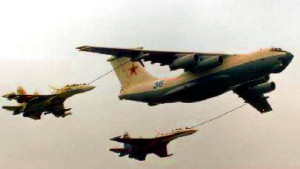INDIA DEFENCE CONSULTANTS
|
WHAT'S HOT? –– ANALYSIS OF RECENT
HAPPENINGS |
|
IAF
Acquires Mid Air Fuelling CAPABILITY An IDC Analysis (With Inputs From Sayan Majumdar)
|
|
New Delhi, 13
October 2003
After
the CCS cleared the 66 AJT Hawk 115 order worth $1.3 b, there was a
spurt in clearance of orders for defence equipment. The media in
India and Gazeta from Russia had both reported that Defence
Secretary Ajay Prasad, Mr Denisov of Rosoboron Export and Maj Gen
Yasi Ben Hanan of the Israeli Aircraft Industries had all signed the
Phalcon order. This was a $1billion tri-country deal. China is
likely to be upset as it was denied the same product by USA, after
Israel had got the planes ready. With elections nearing it will be in the present Government's interest to get all the proposed purchases cleared and so hopefully the Scorpene contract may also move forward by year end. Similarly the Gorshkov and MIG 29Ks may get cleared closer to the date when PM Vajpayee visits Moscow to meet President Putin. All this is good news for the services and the recipients of the contracts. We also salute the IAF for displaying their latest MID AIR REFUELLING capability and post below a story that has done many rounds in the past but needs to be re-read. On
7th October the Indian public assembled at Palam Technical Area
and TV viewers witnessed the IFR (In-Flight Refueling) operation
carried out by one of the two (six are on order), recently acquired
Russian Illyushin-78 IFR tanker aircraft that simultaneously
refueled two Sukhoi-30MKI multi-role fighters. Interestingly, the
Russian tanker was equipped with the British ‘probe and drogue’
method that was reportedly successfully smuggled out by the Russian
espionage system during the height of the ‘Cold War’. The
Russians first applied it to their Myasishchyev-4 ‘Bison-A’
bombers converted to tankers, as the British media lamented in their
aerospace publication that “no license was ever paid”. The
other method is the boom method used by USA, which gives more
flexibility to pilots but provides less fuelling stations. The more
recent Illyushin-78 ‘Midas’ IFR tanker, created on the basis of
the Illyushin-76MD freighter, is designed for in-flight refueling
of airplanes of various types. The Illyushin-78 is a three-point
tanker, probe and drogue based on the airframe of the
Illyushin-76MD. It is not clear which company supplied the Drogue
system and we will be happy to receive inputs. The
British ‘probe and drogue’ method involves the tanker carrying
multiple hose-drum units, each comprising a rubber hose which is
unwound from a drum and deployed in the airflow. The compact hose is
accommodated in a pod so the tanker carries one unit in the fuselage
and one in each wing to carry out simultaneous refueling. For safety
reasons usually two recipient aircraft are refueled at a time, one
unit is kept as an emergency backup. The receiver aircraft pilot
edges forward to make contact with the “basket” mounted at the
end of the hose and this operation demands high flying skills from
the receiver pilot. Probes can be seen on the SU 30MKI, Jaguar and
Mirage 2000 aircraft. The flight time is extended but the oxygen can
be a limitation and so oxygen regeneration systems need to be
adapted to increase range. This is also a challenge for the IAF and
it must have been solved. The
IAF should supplement its Illyushin-78 fleet with an adequate number
of fighters equipped with ‘buddy-buddy’ type of refueling pods.
A miniature hose-drum unit is attached to a “wet” pylon of a
tactical aircraft that can sustain one of its formations for a long
distance sortie and if necessary, can fly low and fast in the combat
zone. This type of ‘buddy-buddy’ refueling is of great
importance in naval aircraft-carrier based operations, as the
maximum take-off weight may be above catapult limits. In such
circumstances the fighter may be launched with maximum bomb load and
low fuel to be refueled immediately afterwards by a
‘buddy-buddy’ tanker. We hope that inter-services COOPERATION will
look at this option. With
force multipliers like the Illyushin-78 IFR tankers entering service
with the IAF, to be followed by Phalcon AWACS (Airborne Warning And
Control System) platforms, efforts now should be made to induct a
powerful dedicated EW (Electronic Warfare) escort-jammer to
accompany strike formations in enemy airspace. Potential candidates
include the Russian Sukhoi-32/34 (also referred to as Sukhoi-27IB)
that may be termed as “Jumbo Flanker” for its enhanced weight
and dimensions. Sukhoi-32/34 is destined to serve the Russian Air
Force as their primary "sub-strategic" (range 4000
kilometre plus) nuclear strike aircraft. Numerous other specialised
variants are to follow. If
the IAF on the other hand decides to choose an in-service type,
perhaps a modified Mirage 2000 will fit the bill. Also the air
exercises with United States Air Force that will focus on the
protection of airborne force multipliers are of great significance.
The Air Chief had stated that these will take place early next year
with F 15s which are truly great flying machines. Recently five F18s
and five MIG 29s of Malaysian Air Force demonstrated aerobatics at
LIMA 03 at Lagkawi last week and it was a total treat to see US
and Russian made fighters flying in the same airspace. Gp Capt Effendi the CO of the RMAF MIG 29s stated that both aircraft were a treat and equal to fly but when asked, which he would take to war he chose the F 18s. Now RMAF is getting 18 SU 30 MKM and the planes will have the Indian Mission computer which fact needs to be publicised, as it has proved successful in the SU 30 MKI, which are in the picture for mid air refuelling. |
